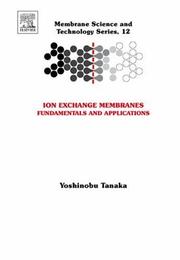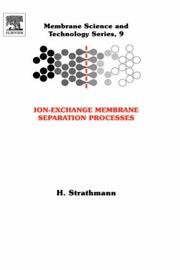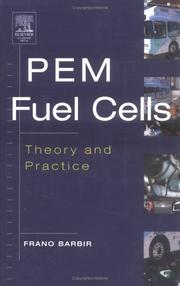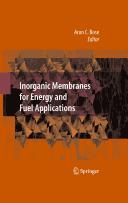| Listing 1 - 9 of 9 |
Sort by
|

ISBN: 1281119806 9786611119805 0080548644 0444519823 9780444519825 9780080548647 Year: 2007 Publisher: Amsterdam Oxford Elsevier
Abstract | Keywords | Export | Availability | Bookmark
 Loading...
Loading...Choose an application
- Reference Manager
- EndNote
- RefWorks (Direct export to RefWorks)
Fundamental study and industrial application of ion exchange membranes started over half a century ago. Through the ongoing research and development, the ion exchange membrane technology is now applied to many fields and contributes to the improvement of our standard of living. Ion Exchange Membranes states the ion exchange membrane technology from the standpoint of fundamentals and applications. Discussing not only various phenomena exhibited by the membranes but also their applications in many fields with economical evaluations.* This volume looks at the latest developments
Ion-permeable membranes. --- Membranes (Technology) --- Artificial membranes --- Separation (Technology) --- Technology --- Ion exchange membranes --- Permeable membranes (Electrodialysis) --- Permselective membranes --- Electrodes, Ion selective --- Electrodialysis --- Ion exchange
Book
ISBN: 0444663215 0444633197 9780444663214 9780444633194 Year: 2015 Publisher: Amsterdam, Netherlands : Elsevier,
Abstract | Keywords | Export | Availability | Bookmark
 Loading...
Loading...Choose an application
- Reference Manager
- EndNote
- RefWorks (Direct export to RefWorks)
Fundamental study and industrial application of ion exchange membranes started over half a century ago. Through ongoing research and development, ion exchange membrane technology is now applied to many fields and contributes to the improvement of our standard of living. Ion Exchange Membranes, 2nd edition states the ion exchange membrane technology from the standpoint of fundamentals and applications. It discusses not only various phenomena exhibited by membranes but also their applications in many fields with economical evaluations. This second edition is updated and revised, featur
Ion-permeable membranes -- Research. --- Ion-permeable membranes -- Testing. --- Chemistry --- Physical Sciences & Mathematics --- Physical & Theoretical Chemistry --- Ion-permeable membranes --- Testing. --- Research. --- Ion exchange membranes --- Permeable membranes (Electrodialysis) --- Permselective membranes --- Electrodes, Ion selective --- Electrodialysis --- Ion exchange --- Membranes (Technology)
Book
ISBN: 1634842006 9781634842006 9781634841993 1634841999 Year: 2016 Publisher: New York
Abstract | Keywords | Export | Availability | Bookmark
 Loading...
Loading...Choose an application
- Reference Manager
- EndNote
- RefWorks (Direct export to RefWorks)
Membranes (Technology) --- Ion-permeable membranes. --- Ionomers. --- Fluoropolymers. --- Copolymers. --- Polymers --- Fluorinated polymers --- Fluorine plastics --- Fluorocarbon polymers --- Fluoroplastics --- Organofluorine compounds --- Ion exchange membranes --- Permeable membranes (Electrodialysis) --- Permselective membranes --- Electrodes, Ion selective --- Electrodialysis --- Ion exchange --- Artificial membranes --- Separation (Technology) --- Technology

ISBN: 044450236X 9786611756185 1281756180 0080509401 9780444502360 9780080509402 Year: 2004 Publisher: Amsterdam Boston Elsevier
Abstract | Keywords | Export | Availability | Bookmark
 Loading...
Loading...Choose an application
- Reference Manager
- EndNote
- RefWorks (Direct export to RefWorks)
Today, membranes and membrane processes are used as efficient tools for the separation of liquid mixtures or gases in the chemical and biomedical industry, in water desalination and wastewater purification. Despite the fact that various membrane processes, like reverse osmosis, are described in great detail in a number of books, processes involving ion-exchange membranes are only described in a fragmented way in scientific journals and patents; even though large industrial applications, like electrodialysis, have been around for over half a century. Therefore, this book is emphasizing
Membrane separation. --- Ion-permeable membranes. --- Membrane separation --- Membranes échangeuses d'ions --- elektrodialyse --- ionuitwisselingsmembraan --- membraanfiltratie --- scheidingstechniek --- Membranes échangeuses d'ions --- Electrodialysis --- Ion-permeable membranes --- Filtration, Membrane --- Membrane filtration --- Separation, Membrane --- Separation (Technology) --- Ion exchange membranes --- Permeable membranes (Electrodialysis) --- Permselective membranes --- Electrodes, Ion selective --- Ion exchange --- Membranes (Technology) --- Dialysis --- Industrial applications --- Electrodialysis. --- Industrial applications.
Book
ISBN: 3642448739 3642361870 3642361889 Year: 2013 Publisher: New York : Springer,
Abstract | Keywords | Export | Availability | Bookmark
 Loading...
Loading...Choose an application
- Reference Manager
- EndNote
- RefWorks (Direct export to RefWorks)
Reference Electrodes are a crucial part of any electrochemical system, yet an up-to-date and comprehensive handbook is long overdue. Here, an experienced team of electrochemists provides an in-depth source of information and data for the proper choice and construction of reference electrodes. This includes all kinds of applications such as aqueous and non-aqueous solutions, ionic liquids, glass melts, solid electrolyte systems, and membrane electrodes. Advanced technologies such as miniaturized, conducting-polymer-based, screen-printed or disposable reference electrodes are also covered. Essential know-how is clearly presented and illustrated with almost 200 figures.
Biological systems. --- Electrochemistry. --- Electrodes, Ion selective. --- Electrodes. --- Chemistry --- Physical Sciences & Mathematics --- Physical & Theoretical Chemistry --- Eletrolysis. --- Chemistry. --- Analytical chemistry. --- Analytical Chemistry. --- Electric resistors --- Analytical biochemistry. --- Analytic biochemistry --- Biochemistry --- Chemistry, Analytic --- Physical sciences --- Bioanalytic chemistry --- Bioanalytical chemistry --- Analytical chemistry --- Analysis, Chemical --- Analytic chemistry --- Chemical analysis --- Chemistry, Physical and theoretical

ISBN: 0120781425 9786610630448 1280630442 0080455417 9780080455419 9780120781423 Year: 2005 Publisher: Amsterdam London Elsevier Academic
Abstract | Keywords | Export | Availability | Bookmark
 Loading...
Loading...Choose an application
- Reference Manager
- EndNote
- RefWorks (Direct export to RefWorks)
Fuel cells are electrochemical energy conversion devices that convert hydrogen and oxygen into water, producing electricity and heat in the process and providing fuel efficiency and reductions in pollutants. Demand for this technology is growing rapidly. Fuel cells are being commercialized for stationary and portable electricity generation, and as a replacement for internal combustion engines in automobiles. Proton Exchange Membrane (PEM) fuel cells in particular are experiencing an upsurge. They have high power density and can vary their output quickly to meet shifts in power demand.
Fuel cells. --- Ion-permeable membranes. --- Piles à combustible --- Membranes échangeuses d'ions --- Ion exchange membranes --- Permeable membranes (Electrodialysis) --- Permselective membranes --- Electrodes, Ion selective --- Electrodialysis --- Ion exchange --- Membranes (Technology) --- Direct energy conversion --- Electric batteries --- Electric power production from chemical action --- Electrochemistry
Book
ISBN: 012398372X 0123877105 9780123877109 Year: 2013 Publisher: Amsterdam ; Boston : Elsevier/Academic Press,
Abstract | Keywords | Export | Availability | Bookmark
 Loading...
Loading...Choose an application
- Reference Manager
- EndNote
- RefWorks (Direct export to RefWorks)
Demand for fuel cell technology is growing rapidly. Fuel cells are being commercialized to provide power to buildings like hospitals and schools, to replace batteries in portable electronic devices, and as replacements for internal combustion engines in vehicles. PEM (Proton Exchange Membrane) fuel cells are lighter, smaller, and more efficient than other types of fuel cell. As a result, over 80% of fuel cells being produced today are PEM cells. This new edition of Dr. Barbir's groundbreaking book still lays the groundwork for engineers, technicians and students better than any other
Proton exchange membrane fuel cells. --- Ion-permeable membranes. --- Fuel cells. --- Sustainable Development --- Environmental Sciences --- Direct energy conversion --- Electric batteries --- Electric power production from chemical action --- Electrochemistry --- Ion exchange membranes --- Permeable membranes (Electrodialysis) --- Permselective membranes --- Electrodes, Ion selective --- Electrodialysis --- Ion exchange --- Membranes (Technology) --- PEFCs (Fuel cells) --- PEM fuel cells --- PEMFCs (Fuel cells) --- Polymer electrolyte fuel cells --- Polymer electrolyte membrane fuel cells --- Proton conducting membrane fuel cells --- Fuel cells
Book
ISBN: 3642431623 3642368859 3642368867 Year: 2013 Publisher: New York : Springer,
Abstract | Keywords | Export | Availability | Bookmark
 Loading...
Loading...Choose an application
- Reference Manager
- EndNote
- RefWorks (Direct export to RefWorks)
Ion-selective electrodes (ISEs) have a wide range of applications in clinical, environmental, food and pharmaceutical analysis as well as further uses in chemistry and life sciences. Based on his profound experience as a researcher in ISEs and a course instructor, the author summarizes current knowledge for advanced teaching and training purposes with a particular focus on ionophore-based ISEs. Coverage includes the basics of measuring with ISEs, essential membrane potential theory and a comprehensive overview of the various classes of ion-selective electrodes. The principles of constructing ISEs are outlined, and the transfer of methods into routine analysis is considered. Advanced students, researchers, and practitioners will benefit from this expedient introduction.
Chemistry --- Physical Sciences & Mathematics --- Analytical Chemistry --- Electrodes, Ion selective. --- Electrochemical analysis. --- Analysis, Electrochemical --- Analysis, Electrolytic --- Electroanalysis --- Electrolytic analysis --- Ion selective electrodes --- Ion sensitive electrodes --- Specific ion electrodes --- Chemistry. --- Laboratory medicine. --- Analytical chemistry. --- Food --- Electrochemistry. --- Analytical Chemistry. --- Environmental Monitoring/Analysis. --- Laboratory Medicine. --- Food Science. --- Biotechnology. --- Chemistry, Analytic --- Electrochemistry --- Electrochemical analysis --- Electrodes --- Ion-permeable membranes --- Quantitative --- Analytical biochemistry. --- Medical laboratories. --- Food science. --- Monitoring/Environmental Analysis. --- Physical sciences --- Science --- Diagnosis, Laboratory --- Health facilities --- Laboratories --- Analytic biochemistry --- Biochemistry --- Bioanalytic chemistry --- Bioanalytical chemistry --- Analytical chemistry --- Environmental monitoring. --- Food—Biotechnology. --- Chemistry, Physical and theoretical --- Clinical medicine --- Clinical pathology --- Diagnostic laboratory tests --- Laboratory diagnosis --- Laboratory medicine --- Medical laboratory diagnosis --- Diagnosis --- Pathology --- Biomonitoring (Ecology) --- Ecological monitoring --- Environmental quality --- Monitoring, Environmental --- Applied ecology --- Environmental engineering --- Pollution --- Analysis, Chemical --- Analytic chemistry --- Chemical analysis --- Measurement --- Monitoring

ISBN: 0387345248 1441922377 9786611810535 1281810533 0387345264 Year: 2009 Publisher: New York : Springer,
Abstract | Keywords | Export | Availability | Bookmark
 Loading...
Loading...Choose an application
- Reference Manager
- EndNote
- RefWorks (Direct export to RefWorks)
The study of inorganic membrane materials and processes is a rapidly expanding research interest area. This is due to the recognition that research results in recent years have created membrane-based technology modules with the potential to improve the cost, efficiency, and environmental performances of energy production systems beyond current benchmarks. This book documents progress in inorganic membranes, especially in advanced materials and novel separation concepts, with applications for cost-effective and environmentally-progressive energy production solutions. The book chapters address inorganic membranes on three transport mechanisms, i.e., mixed ion-electron conduction, solution-atomic diffusion, and size exclusion filtration of the permeate phase. Inorganic Membranes for Energy and Environmental Applications provides a single source reference for researchers contemplating continued advancement of inorganic membrane technology to novel capabilities for applications to future energy and fuel production systems and potentially, technology-based responses to address greenhouse gas emission concerns. This book is meant for scientists, engineers, industry R&D personnel, and graduate students engaged in the development, engineering scale-up, and applications of inorganic membrane materials and processes, and non-technical management staff delegated with programmatic and resource allocation decision authorities who need to know about state-of-the-art current inorganic membrane technology.
Membranes (Technology). --- Membranes (Technology) --- Inorganic ion exchange materials --- Ion-permeable membranes --- Gas separation membranes --- Hydrogen --- Oxygen --- Power resources --- Electric power production --- Chemical & Materials Engineering --- Engineering & Applied Sciences --- Chemical Engineering --- Ion-permeable membranes. --- Gas separation membranes. --- Electric power production. --- Power resources. --- Inorganic ion exchange materials. --- Inorganic ion exchangers --- Ion exchange materials, Inorganic --- Energy --- Energy resources --- Power supply --- Electric power generation --- Electricity generation --- Power production, Electric --- Ion exchange membranes --- Permeable membranes (Electrodialysis) --- Permselective membranes --- Artificial membranes --- Chemistry. --- Analytical chemistry. --- Inorganic chemistry. --- Electrochemistry. --- Chemical engineering. --- Energy industries. --- Materials science. --- Industrial Chemistry/Chemical Engineering. --- Analytical Chemistry. --- Energy Economics. --- Materials Science, general. --- Inorganic Chemistry. --- Chemistry, Inorganic --- Materials --- Natural resources --- Energy harvesting --- Energy industries --- Electric power systems --- Electrification --- Electrodes, Ion selective --- Electrodialysis --- Ion exchange --- Separation (Technology) --- Technology --- Analytical biochemistry. --- Materials. --- Chemistry, inorganic. --- Energy Policy, Economics and Management. --- Inorganic chemistry --- Chemistry --- Inorganic compounds --- Physical sciences --- Engineering --- Engineering materials --- Industrial materials --- Engineering design --- Manufacturing processes --- Analytic biochemistry --- Biochemistry --- Chemistry, Analytic --- Chemistry, Industrial --- Engineering, Chemical --- Industrial chemistry --- Chemistry, Technical --- Metallurgy --- Bioanalytic chemistry --- Bioanalytical chemistry --- Analytical chemistry --- Energy policy. --- Energy and state. --- Chemistry, Physical and theoretical --- Material science --- Energy and state --- State and energy --- Industrial policy --- Energy conservation --- Analysis, Chemical --- Analytic chemistry --- Chemical analysis --- Government policy
| Listing 1 - 9 of 9 |
Sort by
|

 Search
Search Feedback
Feedback About UniCat
About UniCat  Help
Help News
News